Adrian Park looks at West Air Sweden flight 294, on 8 January 2016
The rapid and total destruction of a night freight jet is a grim reminder of the high level of systems knowledge expected of aircrew in the modern glass cockpit era, and of the horrible contrast between routine and startle.
Reality is straightforward for pilots: push forward on the stick and the nose goes down. Pull backward and the nose comes up. From every pilot’s very first flight this Newtonian reality is confirmed by looking at both the real horizon and the artificial one. Push forward: nose goes down/horizon comes up; pull back: nose comes up/horizon goes down.
‘Trust your instruments!’ we are told over and over again. It’s a simple and reliable reality for pilots.
Except when it isn’t.
It’s the eighth day of 2016, northern Sweden, and a Bombardier CRJ 200 is hauling 4500 kg of mail. There is a Spanish captain and a French first officer, high in the dome of the polar night.
The first sign something is seriously wrong is a continuous ‘cavalry charge’ sound of the autopilot disconnecting. The second sign is an expletive from the left pilot (the captain). On hearing the audio warning he’d looked down at his primary flight display (PFD) and was startled to see the pitch increasing at an alarming rate. At 33,000 feet, nearing midnight in the sub-Arctic darkness, and with no moon this is what he saw:
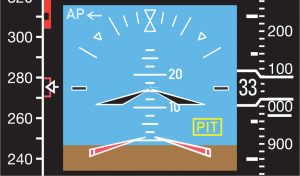
The captain did what he and every other pilot has been trained to do—he trusted his instruments. He pushed forward expecting the comforting reality he’d experienced so many times before: nose going down/horizon coming up. Except nothing happened on the PFD. He pushed forward again, much harder this time, but the nose kept coming up and the horizon kept going down—the exact opposite of what he expected.
Meanwhile, the first officer to his right had a different reality on his PFD:
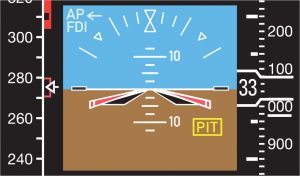
The rendered blue and brown of the first officer’s PFD showed a more benign reality—half sky, half ground. A perfectly normal cruise attitude. In fact, if it had been the first officer on the right-hand side flying, while the captain on the left was looking at an instrument approach plate (instead of the other way around) the first officer wouldn’t have even noticed the number 1 PFD pitch-up. All he would have seen was a small yellow ‘PIT’ annunciation in the bottom right corner of his own correctly indicating PFD.
In all probability he would have queried the mismatch with the captain who would probably have noticed his own PFD was erroneously pitching up. In any case, either pilot could have glanced at the perfectly functional standby attitude indicator to get orientated on the real horizon. Neither did.
Instead the captain, on seeing the malfunctioning PFD indication, was startled by what appeared to him to be a dangerously nose-high attitude. He uttered, as the report from the Swedish accident investigation authority Statens haverikommission daintily put it, a ‘strong expression’ and pushed hard on the yoke.
The co-pilot wasn’t looking at his PFD when the trouble started. He had no reason to. His was head down looking at the approach chart for Tromsø/Langnes in far northern Norway. Up to this point he’d been enjoying a rather routine flight. Take-off from Oslo/Gardermoen had been quite pleasant—poetic even. As the CRJ 200 taxied out the snow had been light, the kind of snow everybody likes, even pilots. There was no visibility-reducing kind that swirls in congested clouds of disorientating white. It seemed to bode a comfortably routine flight.
As flight 294 lined up on the runway the pilots were comfortable in the knowledge operational briefings had been dutifully refreshed, the weather carefully considered, waypoints programmed, and the night instrument departure briefed. All that needed to be done now was a quick and final check of the instruments. A glance down and it was confirmed—good to go. No yellow or red malfunction symbols: nothing but the comforting glow of caution-free PFDs. The thrust levers were pushed forward and flight 294 took off and climbed smoothly into the night sky. This seemed to be just another take-off, just another flight—just another day.
Except deep inside the heart of the number one inertial reference unit (IRU)—somewhere in the solid-state electronics of the laser ring gyro—a small glitch had developed. And it really was small. There was no catastrophic impact of geese into fast-spinning turbine blades. Nor was it the horrid sound of fatigued metal giving way. It was merely a digital malfunction of the IRU with almost no physical effect except a false pitch indication on the left side PFD. Just that one. Not the first officer’s PFD nor the standby attitude indicator—they were perfectly normal.
Just before the approach, as the crew were busy prepping for the landing, the glitch manifested. The autopilot kicked off, the audio warning sounded, and the erroneous pitch-up indication began. Without a visual horizon and with both pilots concentrating on the approach checklist, the combined influence was enough to induce startle effect and cause the captain to bunt forward.
For the first officer the startle factor was even greater. In the glow of the cockpit reading lights he had had his head down in checklists and approach plates. There’s no doubt he would have heard the chime and heard the captain swearing. Then, as he lifted his head to see what was going on, he would have been flung upwards against his straps as the aeroplane bunted. The bunt was, in fact, so vicious that the cockpit voice recorder registered thumping noises as loose objects hit the roof. Other audio warnings sounded one after the other. A single chime. Then a triple chime. Then the synthetic voice of the caution system ‘Low engine oil pressure’ and then the stabiliser trim clacker protesting the rapid and dangerous use of stabiliser trim. All of this was a result of the negative G and the deepening dive.
‘What the f …!’
The first officer’s ‘strong expression’ added to the cacophony in the cockpit. It was certainly justified. No pilot enjoys abrupt and unannounced negative G. In fact, the surest way to scare a pilot is to subject them to a severe impromptu bunt. On a sky-clear day it’s bad enough. At night, in cloud, it’s kryptonite to a pilot’s composure.
Desperate for information from his instruments—and midst the chaos of flying objects, warning alerts and expletives from both his own mouth and that of the captain—the first officer noticed an alarming pitch-down developing on his PFD.
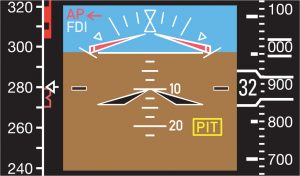
‘Come up!’ he said.
‘Come on, help me, help me, help me …’ said the captain.
Both were now experiencing extreme duress. The most fundamental principle of controlled flight had failed—push forward: nose goes down/horizon comes up; pull back: nose comes up/horizon goes down. The captain was pushing … really pushing. But the nose kept rising and the horizon kept falling. Warning after warning harangued the crew. Unrelenting and harrowing confusion had replaced routine. Had some critical control failed? Was some structural component coming apart? Were they in the vicious grip of some sort of turbulence? Why couldn’t they get this damn machine under control?
At 20 degrees nose down (or 30 degrees nose up) the PFDs were designed to enter ‘declutter’ mode. This was a clever feature the manufacturer had built in for unusual attitudes (UA). The declutter mode removed all ‘unnecessary’ symbology—including the yellow ‘PIT’ miscompare annunciator. All that remained was basic attitudinal symbology and red chevrons pointing in the direction the pilot should point the nose to recover from the UA. The small but crucial symbol that could have saved their lives—the ‘PIT’ annunciator—was deemed non-essential and swept away. All the first officer saw was this:
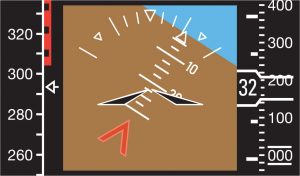
Meanwhile, the captain’s PFD had also entered declutter mode. In orientation-robbing contrast, this is what the captain saw:
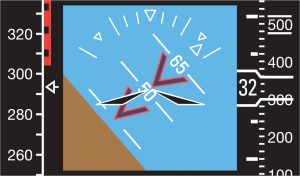
With both pilots befuddled by incongruent blues, browns and red chevrons, the reality and the import of the real horizon continued to elude them. Communication became confused.
‘Turn right’ said the first officer.
‘What? … help me, help me’ said the captain.
‘I’m trying, turn left, turn left.’
‘Mayday, mayday, mayday Air Sweden 294!’
The co-pilot was trying to get a mayday call out, but he hadn’t activated the transmit switch. He tried again.
This call made it out and ATC grimly acknowledged. But there was nothing they could do. There was nothing anyone could do.
‘Mayday, mayday, mayday, we are turning back!’ transmitted the first officer again.
‘We need to climb, we need to climb!’ interjected the captain.
‘Yeah, we need to climb …’
‘Turn left, turn left …’
‘No, continue right, continue …’
‘No, help me, help me please …’
(synthetic voice) ‘Bank angle!’
‘I don’t know, I don’t see anything …’
‘OK’
‘OK, OK, ya,’
(strong expression)
‘I think you were the right to correct,’
(synthetic voice) ‘Bank angle!’
With the nose nearly 40 degrees down and the aircraft in a steepening left turn the overspeed clacker suddenly went off—the maximum operating speed of 315 knots and maximum Mach number of 0.85 had been exceeded. What had once been the comforting and coherent glow of consistent left- and right-pilot PFDs now looked like this:
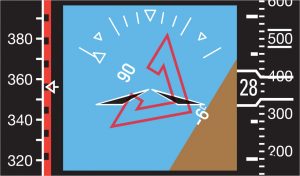
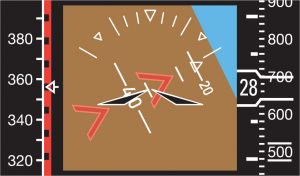
The airspeed soon increased to over 400 knots and the rate of descent to over 20,000 feet per minute—far beyond any published design criteria. Angle of bank soon increased to the point where the aircraft had become inverted.
Overspeed clacker ends.
‘What the …?’ (strong expression)
(strong expression)
(strong expression)
(synthetic voice) ‘Bank angle!’
Single chime.
End of recording
A mere 80 seconds after the erroneous pitch up the CRJ 200 collided with the ground. It was inverted doing 500 knots. There were no survivors.
I find the warring realities on the PFDs on flight 294 horrifying. It seems almost obscene that a modern aircraft with relatively well-trained and experienced crew could fall victim to such a catastrophic crash—and yet here it is.
There are many things that could be said. The importance of awareness training around ‘startle effect’ would be one. Another would be the criticality of drilled communication during adverse events. Yet another would be the issues around the human machine interface in modern aircraft—something we evidently have not yet completely solved. The accident investigation covers off on these issues and many others and can be read here.
Would any of us have done better? We might like to think so but only those of us who have looked startle factor in the eye can be sure. And maybe not even then because every startle is unique; past results are no guarantee of future performance, as the fine print on your super statement says. Add bunt next time and see how you go.
There are many things that could be said. The importance of awareness training around ‘startle effect’ would be one. Another would be the criticality of drilled communication during adverse events.
Applying a proverb to such a rare, frightening and rapidly lethal event seems almost as short sighted as applying undiluted hindsight and saying, ‘that could never happen to me’. And yet there’s one proverb that fits. In Russian it’s ‘doveryai, no proveryai’, which translates into English as ‘trust, but verify’. Appropriately, this saying has a pedigree in terror. It emerged as the catchphrase of the Intermediate Range Nuclear Forces Treaty between the US and the Soviet Union in 1987.
So, trust your instruments but verify, against the other side of the flight deck and the standby instrument. Remember your partial panel checks and how gyroscopic and barometric instruments operate from different physical principles. If your attitude reading is extreme but your airspeed and altitude are steady then it’s the gyros that are gone, and vice versa.
Aviation rightly lauds its pioneers, such as Jimmy Doolittle, who first demonstrated instrument flight nearly 90 years ago. One gyro, one lap of the field, one giant conceptual leap. Cruising on autopilot it’s easy to forget what a huge leap it was. A century of refinement and improvement has made the lives of modern pilots easier in some ways, and certainly safer. Except when something goes wrong, in a new and unanticipated way, creating a fiendish problem with almost no time to solve it.
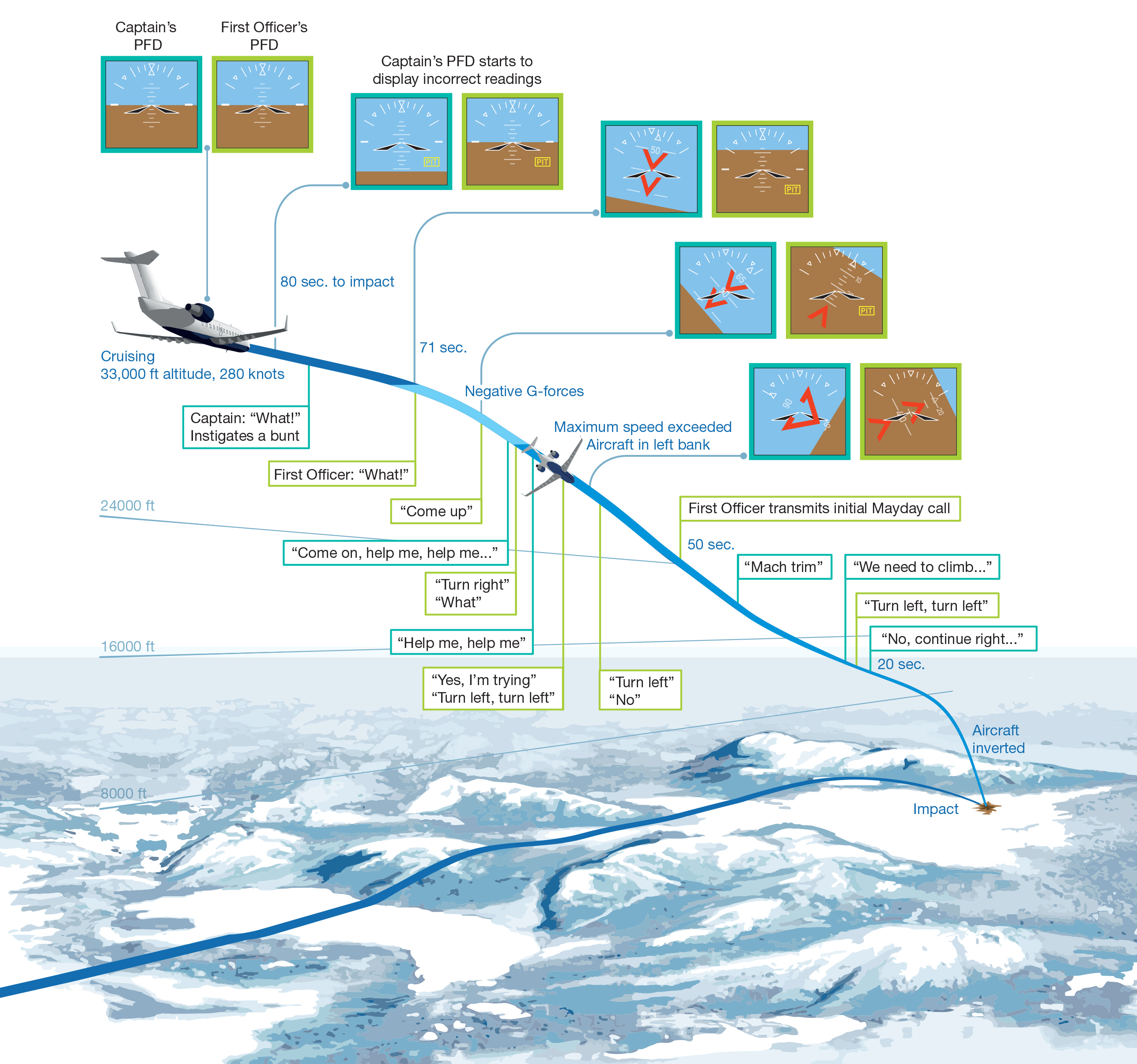



As a technician who has built many electronic circuits, and repaired many more, this article reinforces my preference for the old analogue flight instruments. (Which are what I learned to fly with.) The main thing I dislike about glass PFD’s is the woefully small airspeed indicator (and altitude indicator). But electronic failures also are a lot more possible than most people think they are. We are heading into a time when many electronic problems are hard to even diagnose, if not repair, and we’re putting them into planes and cars expecting them to be fail-safe or fail proof.
I recall an incident comparable in specifically limited ways with ‘trust, but verify’ which occurred decades ago now.
I had achieved all my commercial subjects bar the final exam and held a twin engine rating.
I was employed in a capacity unrelated to aviation in any direct context by an organization operating several older light twins equipped with analogue instruments on single pilot operations ferrying staff around remote areas.
Being located in such a region at the time of the incident I was acquainted with all the regular pilots.
As occurred from time to time I was an only passenger on a relatively short flight and being aware of my qualifications and a shared love of flying once established on cruise the duty pilot asked if I “would like a bit of joint time on the controls”.
It was an offer some of the regular pilots occasionally made under such circumstances and they rarely needed to make it twice.
The aircraft was cruising at an instrument altitude which naturally stipulated greatest attainable precision with regard to maintenance of level but on this occasion I found myself encountering a new experience.
This is what happened;
After a brief interval of joint time at the controls I made what with reference to the right hand altimeter I believed to be a necessary altitude correction.
The pilot in command immediately applied gentle forward pressure until the aircraft had descended to the previous altitude where he then resumed straight and level flight.
Upon checking the altimeter on my side I determined that the aircraft was now below the planned level at an unacceptable margin and instigated a gentle climb to rectify that.
The pilot immediately counteracted my action and politely commented regarding the standard requisite to instrument operations which naturally gave me to reflect upon what was transpiring.
After a few moments it occurred to me that with regard to single pilot operations a pilot in command might well not bother to adjust the barometric setting for QNH on the right hand altimeter.
This is because not only is the right hand altimeter awkward to reach, the window for the barometric setting is difficult to read accurately from the left hand seat of the aircraft in question.
When I inquired, the pilot in command provided the QNH he was using which I also applied and the problem was resolved.
While it was a relatively minor incident given a substantial margin of altitude in hand and good visibility, if subject to IFR conditions at lower level it could have been far more serious and is a lesson I have never forgotten.
Mankind has come far since he first left the ground to emulate the birds & fly, much has been invented, designed and implemented, have we really come that far? All we really have done is find different ways to achieve the same end result!
Safety is all in the mind.